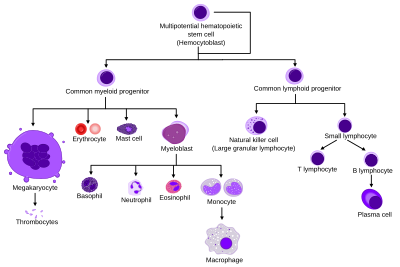
Back تكون الدم Arabic Хемопоеза Bulgarian Hematopoeza BS Hematopoesi Catalan Krvetvorba Czech Hämatopoese German Αιμοποίηση Greek Hematopojezo Esperanto Hematopoyesis Spanish Hematopoiesi Basque

Haematopoiesis (/hɪˌmætəpɔɪˈiːsɪs, ˌhiːmətoʊ-, ˌhɛmə-/,[1][2] from Greek αἷμα, 'blood' and ποιεῖν 'to make'; also hematopoiesis in American English; sometimes also h(a)emopoiesis) is the formation of blood cellular components. All cellular blood components are derived from haematopoietic stem cells.[3] In a healthy adult human, roughly ten billion (1010) to a hundred billion (1011) new blood cells are produced per day, in order to maintain steady state levels in the peripheral circulation.[4][5][page needed]
- ^ "hematopoiesis". Merriam-Webster.com Dictionary. Retrieved 16 May 2022.
- ^ "haematopoiesis". Dictionary.com Unabridged (Online). n.d. Retrieved 16 October 2019.
- ^ Birbrair, Alexander; Frenette, Paul S. (1 March 2016). "Niche heterogeneity in the bone marrow". Annals of the New York Academy of Sciences. 1370 (1): 82–96. Bibcode:2016NYASA1370...82B. doi:10.1111/nyas.13016. ISSN 1749-6632. PMC 4938003. PMID 27015419.
- ^ Semester 4 medical lectures at Uppsala University 2008 by Leif Jansson
- ^ Parslow TG, Stites DP, Terr AI, Imboden JB (1997). Medical Immunology (1 ed.). Appleton & Lange. ISBN 978-0-8385-6278-9.
© MMXXIII Rich X Search. We shall prevail. All rights reserved. Rich X Search